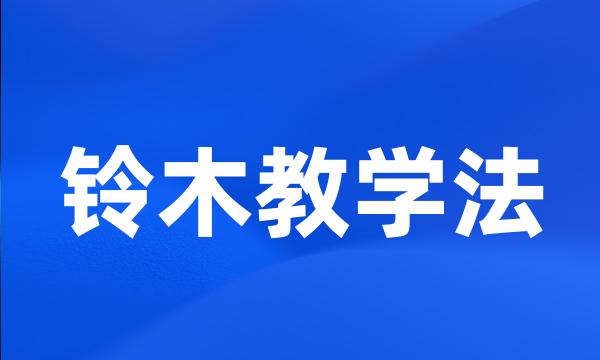铃木教学法
- 网络suzuki method;suzuki pedagogy
 铃木教学法
铃木教学法-
这并不奇怪,因为上世纪70年代末,小林武史(TakeshiKobayashi)把铃木教学法带到了委内瑞拉,帮助那里的弱势儿童组成乐队,演奏音乐。
The parallel is not surprising since Takeshi Kobayashi brought the Suzuki Method to Venezuela in the late 1970s , teaching a group of underprivileged children to play in an orchestra .
-
到了20世纪70年代,铃木教学法已经在全球遍地开花。
By the 1970s , the Suzuki Method had become a worldwide phenomenon .
-
铃木镇一创办了才能教育研究会(TalentEducationResearchInstitute)。该教育机构的资料显示,目前在46个国家有40万儿童正在铃木教学法的帮助下学习演奏乐器,其中仅有2万儿童是日本人。
According to the Talent Education Research Institute , an educational organization founded by Mr. Suzuki , about 400,000 children in 46 countries are now learning to play musical instruments the Suzuki way .
-
尽管存在这种担忧,但日本政府和公众似乎都不知道,迄今为止,日本最成功的文化输出名为铃木教学法(SuzukiMethod)的一种音乐教学方式具有怎样的全球影响力。
Despite this concern , both the Japanese government and the Japanese people seem unaware of the global impact of Japan 's most successful cultural export to date : the so-called Suzuki Method of music instruction .
-
从20世纪30年代诞生开始,铃木教学法就遭到误解。
The Suzuki pedagogy was misunderstood from its very beginnings in the 1930s .
-
世界上的其他地方最终采用了铃木教学法,因为它效果很好。
The rest of the world eventually took to the method because it worked .
-
铃木教学法自上世纪50年代创立以来已经教授了上百万名学习小提琴的孩子。
The Suzuki method has taught millions of children since it was launched by the Japanese violinist in the late 1950s .
-
个小提琴教师名叫铃木镇一,为百万人所用的铃木教学法的创始人,曾经宣称他早年在德国学习了八年时间,爱因斯坦还做过他的监护人。
Shinichi Suzuki , founder of the Suzuki method which has been used by millions , claimed he spent eight years studying in Germany and cited Einstein as his ' guardian ' .
-
从20世纪30年代诞生开始,铃木教学法就遭到误解。铃木镇一20到30岁之间的大部分时间都在柏林度过,返回东京之后,有很多人想聘请他为师。
The Suzuki pedagogy was misunderstood from its very beginnings in the 1930s . Upon returning to Tokyo from Berlin , where he had spent most of his twenties , Mr. Suzuki found himself in high demand as a teacher .
-
该教育机构的资料显示,目前在46个国家有40万儿童正在铃木教学法的帮助下学习演奏乐器,其中仅有2万儿童是日本人。
According to the Talent Education Research Institute , an educational organization founded by Mr. Suzuki , about 400000 children in 46 countries are now learning to play musical instruments the Suzuki way . But just 20000 of them are Japanese .
-
铃木小提琴教学法本身就适合同类乐器的教学,将其引入到二胡教学当中是极其很重要的尝试。
Suzuki violin teaching method itself is suitable for the teaching of similar musical instruments , the erhu to the introduction of teaching which is very very important to try .
-
铃木小提琴教学法在历史的长河中算是发展比较晚的,但最晚的也是离我们最近的,我们就能更正确地把握其原理。
Suzuki violin teaching method in the long river of history is relatively late development , but also the latest from us recently , and we will be able to more accurately grasp the principle .
-
铃木钢琴教学法的教学目标不是培养专门的钢琴演奏人才,而是在教学生如何使用钢琴这门乐器表达音乐的过程中,培养其音乐素养,丰富其精神世界,健全其人格品质。
Its purpose is not cultivate professional pianists , but to teach the students how to use this instrument to express the beauty of music , to develop their musical ability , enrich their spiritual worlds and develop their personalities .
-
在铃木小提琴教学法中,主要研究其特点,包括对学琴孩子和家长的要求、学琴前的准备、教学内容、教学形式、读谱与音乐表现和定期举办音乐会的必要性。
The main characteristics are discussed in the first part , Suzuki violin teaching method , including the requirements for the children and parents and the learning preparation , teaching contents , teaching style , score reading and musical performance and the necessity for periodic concerts .
